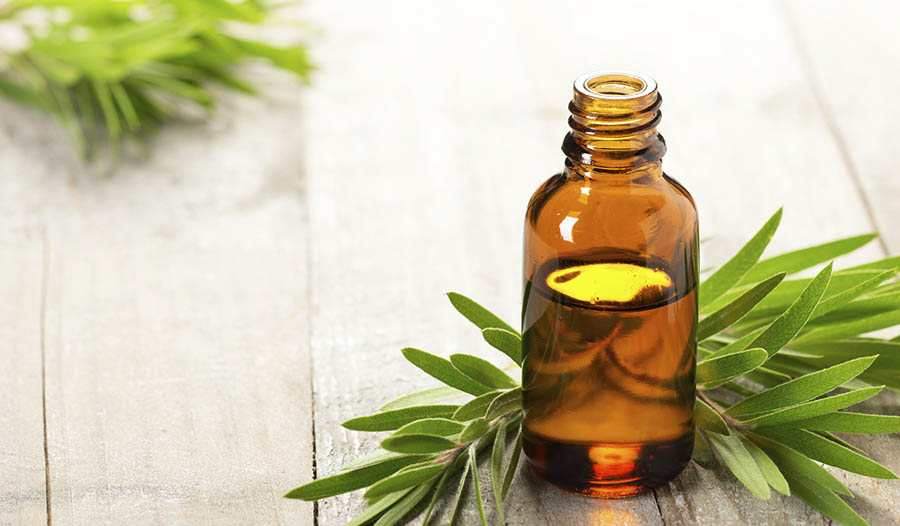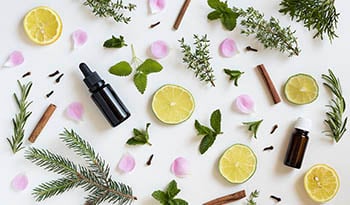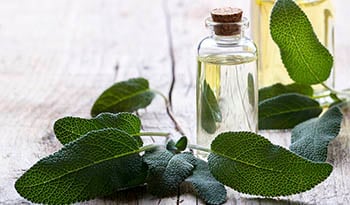Top 13 Essential Oils and How They Can Benefit Your Health
DISCLAIMER:This blog does not intend to provide diagnosis...
- In this article:
- 1. Lavender (Lavandula officinalis)
- 2. Rosemary (Rosmarinus officinalis)
- 3. Tea Tree (Melaleuca alternifolia)
- 4. Lemon (Citrus limonum)
- 5. Peppermint (Mentha piperita)
- 6. Eucalyptus (Eucalyptus globulus, Eucalyptus sideroxylon and Eucalyptus torquata)
- 7. Clove (Syzygium aromaticum)
- 8. Chamomile (Anthemis nobilis)
- 9. Frankincense (Boswellia carterii)
- 10. Myrrh (Commiphora myrrha)
- 11. Grapefruit (Citrus paradisi)
- 12. Oregano (Origanum vulgare)
- 13. Ginger (Zingiber officinale)

Since the beginning of human civilization, people have sought out the benefits of essential oils. The Egyptians used essential oils during the mummification process and ceremonial celebrations. The oils were highly valued, frequently given as gifts and even traded as currency. In the Bible, the Three Wise Men brought the baby Jesus gifts of gold, frankincense and myrrh—the latter two were essential oils.
Essential oils were used by our ancestors in fragrances and perfumes. In addition to their pleasant aroma, most also have health benefits. Essential oils are frequently used in air diffusers, a device that aerosolizes the oil-water mixture into the air. Topical use on the skin is common as is adding a few drops to bathwater. Some essential oils can also be taken internally.
Here are the top 13 essential oils and their health and beauty benefits.
1. Lavender (Lavandula officinalis)
Lavender’s sweet smell is probably one of the most well known and recognized of all essential oils. The oil has been used for thousands of years by cultures all over the world. Its earliest recorded use was by the Greeks and Romans. Lavender can be used for the following:
- Stress reduction – Inhaling lavender can help reduce physical and mental stress levels
- Insomnia – Helps improve quality of sleep if used topically and inhaled
- Blood pressure – A 2017 study showed lavender lowered blood pressure after open-heart surgery while a 2015 study also showed blood pressure benefits
- Bug repellent – While the smell is attractive for humans, bugs don’t like it
- Bug bites – Helps minimize risk of infection and reduces itching when applied topically
- Mild burns – Helps reduce pain from burns. Apply directly or mix with coconut oil
- Eczema – Apply directly on dry skin or mix with coconut oil to relieve symptoms
- Nausea – Helps minimize effects of nausea. Place a drop behind your ears or consider consuming a drop in your mouth or in a small glass of water
- Acne – Apply topically to help prevent worsening of acne
- Pain reliever – Helps provide relief to sore muscles and joints when applied during a massage
- Pain relief during surgery – Studies show use of lavender during surgery reduces pain levels
- Carpal Tunnel Syndrome – S2017 study in the Journal of Hand Therapy showed lavender reduced pain when applied topically
- Hair growth – Studies using animal models show lavender oil can help with hair growth
- Digestion- Aids in the digestive process
Lavender essential oil blends well with clove and rosemary oils.
2. Rosemary (Rosmarinus officinalis)
Rosemary is a common herb that is often grown in home gardens. It has been shown to have many health benefits and, according to an article in New York Times, rosemary plays a big part in the diet of one of the world’s healthiest and oldest living populations, those who reside in Acciaroli, Italy. Rosemary can be used for the following:
- Memory – A 2017 study concluded, “Inhalation of the rosemary essential oil increased the memorization of numbers”
- Traumatic Brain Injury (TBI) – A 2016 study using animals showed improved brain function in injured subjects
- Hair loss – A 2015 study showed improved hair growth when applied topically to the scalp. It took 6 months, however, for a difference to be seen
- Upper Respiratory Infections- Inhalation of an herbal mixture containing rosemary minimized symptoms of infection
- Muscle spasms – This essential oil helps to relax muscles when used during a massage
- Antioxidant protection – Rosemary is a potent antioxidant according to studies
- CAUTION: Some may be sensitive to this essential oil and a few have had skin reactions
Rosemary blends well with lavender and peppermint oils
3. Tea Tree (Melaleuca alternifolia)
This essential oil is derived from the leaves of the Melaleuca tree, mostly found in Australia. The aroma of tea tree is described as medicinal and fresh. Tea tree has many benefits:
- Antifungal – Studies have shown that this oil has antifungal properties. I have frequently advised its use for patients seeking a first-line treatment for nail fungus. I recommend applying it once to twice per day to the nail. I have seen good results when applied consistently. It can also be applied to the skin to help treat athlete’s feet, known by doctors as tinea pedis
- Antibacterial – A 2017 study in mice showed inhaled tea tree oil could be helpful in fighting pneumonia. More research is needed before it is used in people this way.
- A 2017 study out of Rome, Italy showed rinsing one’s mouth out with tea tree oil was helpful in those with inflammation due to gingivitis
- Wound healing – Apply topically to help prevent infection
- Helps control dandruff – Apply topically to the scalp to help reduce dandruff
- Insect repellent – When applied topically, helps keep insects away
Tea tree blends well with lavender and myrrh oil
4. Lemon (Citrus limonum)
Lemon is a familiar scent, sour and sweet at the same time. This essential oil has many uses. It is widely used in beauty products due to its antioxidant properties.
- Indigestion – Taken with a glass of water, it can stimulate the digestive process
- Insect repellent – When applied topically, it helps keep insects away
- Disinfectant – Mixed with water, it can be used to gently clean surfaces
- Sore throat – Antioxidant properties helps kill virus in the throat
- Skincare – Mixed with coconut oil and applied to the skin, it helps protect against oxidation.
Lemon blends well with eucalyptus oil.
5. Peppermint (Mentha piperita)
Peppermint is a well-known herb and essential oil. It is actually a hybrid of watermint and spearmint. Its smell is sharp and fresh, and one of its main components is menthol. In recent times, it has been used as flavoring in chewing gum. Peppermint is native to Europe and has numerous health benefits.
- Irritable Bowel Syndrome (IBS) – Peppermint oil helps improve symptoms in those with IBS
- Headache – Can be helpful with tension headaches
- Food flavoring – Can be added to food for additional flavoring
- Nail infection – Applied topically, can help with fungal infections
- Skin infection – A 2012 study showed protection against skin infections
- Upper Respiratory Infection – Inhalation of an herbal mixture containing peppermint minimized symptoms of infection
- Itching due to pregnancy – Topically applied, peppermint helps minimize itching due to pregnancy, according to studies. Avoid oral consumption
- Eczema – Topically applied, helps minimize skin irritation
- Hair growth – A 2014 study in Toxicological Research demonstrated when peppermint was applied topically, it could help with hair growth
Peppermint blends well with lavender, rosemary and eucalyptus oils
6. Eucalyptus (Eucalyptus globulus, Eucalyptus sideroxylon and Eucalyptus torquata)
Eucalyptus is native to Australia, where Aborigines have used eucalyptus to help treat sinus infections, respiratory infections, and pain. Avoid oral consumption of the oil.
- Upper Respiratory Infection – Inhalation of an herbal mixture containing eucalyptus minimizes symptoms of infection according to studies
- Antibacterial – A 2012 study showed protection against bacterial skin infections when applied topically
- Antifungal – Eucalyptus applied topically can kill fungus
- Anti-tumor properties – Studies show eucalyptus can kill tumor cells in the lab
- Natural deodorant – Apply topically to the armpit.
Eucalyptus blends well with lavender and lemon oils.
7. Clove (Syzygium aromaticum)
Derived from the clove tree. The clove is indigenous to Southeast Asia and Indonesia and has numerous health benefits according to a 2014 study, including:
- Antibacterial properties – when applied topically to wounds, can help prevent infection
- Pain relief – Studies show pain relief properties when applied topically to sore joints and muscles.
- Toothaches – Used in the 13th century for pain relief
- Insect repellent – When applied topically, it helps keep insects away
- Oral thrush – Clove oil can be used for treatment of oral thrush
8. Chamomile (Anthemis nobilis)
Chamomile is commonly consumed as an herbal tea for those wanting to get a good night’s sleep. It has a sweet, fruity smell. As an essential oil, it also has numerous health benefits.
- Anxiety – has a calming effect
- Depression – an animal study shows inhalation of chamomile has anti-depression effects.
- Allergies and asthma benefit
- Anti-inflammatory – apply topically to the affected area
- Wound healing – studies show topical application to be helpful in wound healing and preventing infection of skin wounds
- Insomnia
- Eczema – applied topically
- Muscle spasms – applied topically
Chamomile blends well with jasmine and rose oils.
9. Frankincense (Boswellia carterii)
Perhaps best known as a gift given by the Three Wise Men, Frankincense was frequently used in perfumes. It has a woodsy, balsamic aroma. Today, it is commonly used in religious ceremonies, including those by the Catholic Church. Frankincense is also known as boswellia to people in India and Africa, who use it for medicinal purposes, and it was traded in Somalia 5,000 years ago. It’s known to:
- Prevents yeast infections – Studies show frankincense can kill pathogenic yeast
- Calming effective – Can help calm the mind, especially when the oil is aerosolized
- Joint pain – Studies show boswellia can help pain associated with rheumatoid arthritis and osteoarthritis. Consider rubbing the oil on the affected joint or taking boswellia as an oral supplement.
- Asthma – Helps reduce inflammation in those with asthma, according to studies
- Crohn’s Disease – Boswellia can be helpful, according to a 2001 study
Frankincense blends well with lavender and rose oils.
10. Myrrh (Commiphora myrrha)
An essential oil used in antiquity, myrrh was also mentioned in the Bible, in the Old Testament and New Testament 152 times. Further, in India, it is frequently used in Ayurvedic medicine for back and body pain.
- Antioxidant – Protects the body from oxidative damage
- Antibacterial properties
- Antiviral protection
- Antifungal protection
Myrrh blends well with frankincense, geranium and clove oils.
11. Grapefruit (Citrus paradisi)
The grapefruit originated in Barbados, an island in the Caribbean. The grapefruit is a hybrid of an orange and pomelo fruit. China is currently the world’s leading producer of grapefruit while the United States is second. Grapefruit essential oil is extracted from the fruit.
- Stress and anxiety – A 2017 in Complementary Therapies in Medicine showed those undergoing a colonoscopy procedure felt less anxiety when grapefruit essential oil was in use
- Acne – Grapefruit oil has antimicrobial properties, so applying topically is a great way to help with complexion clearing
- Wounds and burns- Helps protect wounds and burns from becoming infected
12. Oregano (Origanum vulgare)
Oregano is a flowering plant originally from the Mediterranean region. It has been used for centuries and has numerous health benefits.
- Anti-inflammatory properties should be topically applied
- Heart disease – Studies show it prevents atherosclerosis or clogging of arteries.
- Digestion- Helps with digestive issues.
- Leaky Gut- Protects the gut from damage and helps create a healthy gut barrier.
- Anti-parasite properties
- Protects against cancer
- Protects against fungal infections, according to research in Scientific Reports
13. Ginger (Zingiber officinale)
This herb is used in foods but also as an essential oil. Ginger has many health benefits.
- Anti-nausea – Frequently used by pregnant women and those undergoing chemotherapy to help control nausea
- Pain relief – Applied topically to the affected joint, has anti-inflammatory properties
- Laxative effect – Helps move the bowels
References:
- Salamati A, Mashouf S, Mojab F. Effect of Inhalation of Lavender Essential Oil on Vital Signs in Open Heart Surgery ICU. Iranian Journal of Pharmaceutical Research : IJPR. 2017;16(1):404-409.
- Complement Ther Med. 2015 Jun;23(3):331-8. doi: 10.1016/j.ctim.2014.12.001. Epub 2014 Dec 11.
- Complement Ther Clin Pract. 2016 Nov;25:75-80. doi: 10.1016/j.ctcp.2016.08.002. Epub 2016 Aug 3.
- J Hand Ther. 2017 Aug 10. pii: S0894-1130(16)30251-4. doi: 10.1016/j.jht.2017.07.004. [Epub ahead of print]
- Lee BH, Lee JS, Kim YC. Hair Growth-Promoting Effects of Lavender Oil in C57BL/6 Mice. Toxicological Research. 2016;32(2):103-108. doi:10.5487/TR.2016.32.2.103.
- https://www.nytimes.com/2016/10/20/world/what-in-the-world/rosemary-and-time-does-this-italian-hamlet-have-a-recipe-for-long-life.html?_r=0
- O.V. Filiptsova, L.V. Gazzavi-Rogozina, I.A. Timoshyna, O.I. Naboka, Ye.V. Dyomina, A.V. Ochkur, The essential oil of rosemary and its effect on the human image and numerical short-term memory, In Egyptian Journal of Basic and Applied Sciences, Volume 4, Issue 2, 2017, Pages 107-111.
- Neurosci Lett. 2016 May 27;622:95-101. doi: 10.1016/j.neulet.2016.04.048. Epub 2016 Apr 22.
- Skinmed. 2015 Jan-Feb;13(1):15-21. Rosemary helps hair growth
- Pathophysiology. 2017 Sep 14. pii: S0928-4680(17)30005-6. doi: 10.1016/j.pathophys.2017.08.002. [Epub ahead of print]
- J Pharm Pharmacol. 2017 Aug 15. doi: 10.1111/jphp.12788. [Epub ahead of print]
- SALVATORI C, BARCHI L, GUZZO F, GARGARI M. A comparative study of antibacterial and anti-inflammatory effects of mouthrinse containing tea tree oil. Oral & Implantology. 2017;10(1):59-70. doi:10.11138/orl/2017.10.1.059.
- Phytomedicine. 2012 Aug 15;19(11):969-76. doi: 10.1016/j.phymed.2012.05.014. Epub 2012 Jun 26.
- Ben-Arye E, Dudai N, Eini A, Torem M, Schiff E, Rakover Y. Treatment of Upper Respiratory Tract Infections in Primary Care: A Randomized Study Using Aromatic Herbs. Evidence-based Complementary and Alternative Medicine : eCAM. 2011;2011:690346. doi:10.1155/2011/690346.
- Akhavan Amjadi M, Mojab F, Kamranpour SB. The Effect of Peppermint Oil on Symptomatic Treatment of Pruritus in Pregnant Women . Iranian Journal of Pharmaceutical Research : IJPR. 2012;11(4):1073-1077.
- Oh JY, Park MA, Kim YC. Peppermint Oil Promotes Hair Growth without Toxic Signs. Toxicological Research. 2014;30(4):297-304. doi:10.5487/TR.2014.30.4.297.
- Phytomedicine. 2012 Aug 15;19(11):969-76. doi: 10.1016/j.phymed.2012.05.014. Epub 2012 Jun 26.
- Cancer Biol Ther. 2008 Mar;7(3):399-403. Epub 2007 Dec 2. (Eucalyptus has antifungal and cancer properties)
- Cortés-Rojas DF, de Souza CRF, Oliveira WP. Clove (Syzygium aromaticum): a precious spice. Asian Pacific Journal of Tropical Biomedicine. 2014;4(2):90-96. doi:10.1016/S2221-1691(14)60215-X.
- Sci China Life Sci. 2017 Jun;60(6):647-655. doi: 10.1007/s11427-016-9034-8. Epub 2017 May 16.
- Srivastava JK, Shankar E, Gupta S. Chamomile: A herbal medicine of the past with bright future. Molecular medicine reports. 2010;3(6):895-901. doi:10.3892/mmr.2010.377.
- van Vuuren S. F., Kamatou G. P. P., Viljoen A. M. Volatile composition and antimicrobial activity of twenty commercial frankincense essential oil samples. South African Journal of Botany. 2010;76(4):686–691. doi: 10.1016/j.sajb.2010.06.001
- Planta Med 2006; 72(12): 1100-1116 Boswellic Acids in Chronic Inflammatory Diseases
- Kimmatkar N, Thawani V, Hingorani L, Khiyani R. Efficacy and tolerability of Boswellia serrata extract in treatment of osteoarthritis of knee-a randomized double blind placebo controlled trial Phytomedicine 2003; 10: 3-7
- Gupta I, Gupta V, Parihar A, Gupta S Ludtke R, Safayhi H. et al . Effects of Boswellia serrata gum resin in patients with bronchial asthma: results of a double-blind, placebo-controlled, 6 week clinical study. Eur J Med Res. 1998; 3 511-4
- Gupta I, Parihar A, Malhorta P, Gupta S, Ludtke R, Safayhi H. et al . Effects of gum resin of Boswellia serrata in patients with chronic colitis. Planta Med. 2001; 67 391-5
- Journal of Medicinal Plants Research Vol. 5(8), pp. 1382-1389, 18 April, 2011 Available online at http://www.academicjournals.org/JMPR
- http://www.sciencedirect.com/science/article/pii/S0278691510001754
- Hong-kui Wei, Gang Chen, Ruo-Jing Wang, Jian Peng, Oregano essential oil decreased susceptibility to oxidative stress-induced dysfunction of intestinal epithelial barrier in rats, In Journal of Functional Foods, Volume 18, Part B, 2015, Pages 1191-1199
- Puškárová A, Bučková M, Kraková L, Pangallo D, Kozics K. The antibacterial and antifungal activity of six essential oils and their cyto/genotoxicity to human HEL 12469 cells. Scientific Reports. 2017;7:8211. doi:10.1038/s41598-017-08673-9.

 By Dr. Eric Madrid, M.D.
By Dr. Eric Madrid, M.D.


